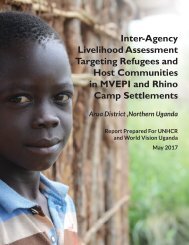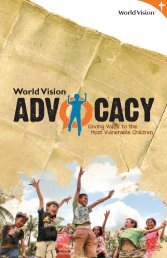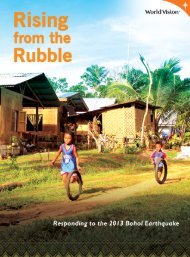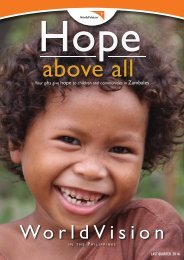SAENER18 Months On Report FINAL (NON-HiRES)
You also want an ePaper? Increase the reach of your titles
YUMPU automatically turns print PDFs into web optimized ePapers that Google loves.
Introduction<br />
Foreword<br />
<strong>On</strong> September 2015, World Vision declared a Category III Emergency Response across the<br />
Southern Africa Region. This was the first emergency declaration among humanitarian<br />
actors and governments across the region. It was premised on vivid early warning data from<br />
our monitoring tools and mechanism. Subsequently, other organisations followed suit and by<br />
December 2015, governments across the regions had begun their emergency declarations in<br />
response to an intense El Niño induced drought.<br />
Our early declaration enabled us to marshal support from the World Vision partnership and<br />
prepare to respond across six countries in the region. However, we were against a number of<br />
challenges due to the competing humanitarian needs across the world specifically the refugee<br />
migration crisis that was affecting most of Europe, the Iraq, and Syrian crises that dominated<br />
both the global humanitarian agenda and the media. These constraints informed our USD 60<br />
Million Response Strategy which was far below the needs that unravelled.<br />
Despite the limited media attention on the unfolding disaster, we remained undeterred; we put<br />
in place the structure and system to engage the public by all means necessary which catapulted<br />
us to become one of the key leaders in the industry. Our various levels of engagement enabled<br />
us to build strong alliances with other NGOs, the United Nations bodies, governments in the<br />
region and the key donor representatives. The response activities attracted the attention of<br />
high profile visitors to the region, and our national offices hosted the USAID Administrator in<br />
Zimbabwe, the UN envoy on El Niño in Swaziland, the British Parliamentary Under-Secretary<br />
of State for International Development in Malawi, the American Ambassadors in Swaziland<br />
and Lesotho. The visitors experienced first-hand the impact of the drought on the communities<br />
and were in turn able to relay their experiences to their constituents which raised the profile of<br />
both the need and our response.<br />
With time, the intensity of the humanitarian need became clearer and, we scaled up our<br />
response to reach 2.6 million people in need of humanitarian assistance. We also ensured<br />
constant prayer for the affected people and our front line staff. At the time of releasing this<br />
report the SAENER response had raised USD209, 972, 267 to meet the needs and have reached<br />
almost 3.5 million people with food aid cash transfers WASH, Protection and complementary<br />
livelihood activities. Our outreach far exceeded our targeted beneficiaries mainly because of<br />
the growing humanitarian needs in Mozambique, Malawi and<br />
Zimbabwe. We cannot underestimate God’s favour in this,<br />
the tireless efforts of our team as well as the generosity of the<br />
donors who entrusted us with the resources.<br />
The magnitude of the Southern Africa El Niño Emergency<br />
Response (SAENER) calls us to higher level of accountability,<br />
transparency and effectiveness especially in addressing the<br />
root cause of re- recurring disasters resulting in food insecurity<br />
in the region. We should ask ourselves the hard questions<br />
especially how to sustainably change the status quo. We aim to<br />
leverage our experience backed up by research to improve our<br />
long term interventions to create resilient communities that<br />
will need of limited external support in future.<br />
Mrs Rudo Kayombo<br />
Regional Leader<br />
8<br />
18 MONTHS ON REPORT Southern Africa El Niño Emergency Response (SAENER)










